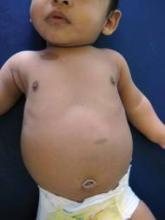Single café au lait macules are found in about 2.5% of infants and typically are of little concern, but certain syndromes should be suspected in children with multiple lesions or in those who develop new lesions after the first 5-6 years of life, according to Dr. Wynnis L. Tom.
For example, multiple café au lait macules (CALMs) could be a sign of neurofibromatosis type I (NF1), Dr. Tom of the University of California, San Diego, said during a presentation at the annual Hawaii Dermatology Seminar sponsored by Skin Disease Education Foundation (SDEF).
Diagnosis of the autosomal dominant syndrome – which results from a neurofibromin defect and occurs in 1 of 2,000-4,500 individuals – requires the presence of two or more of the following diagnostic criteria: six or more CALMs greater than 0.5 cm in diameter in prepubertal children, or greater than 1.5 cm in those postpubertal; two or more neurofibromas of any type, or one plexiform neurofibroma; axillary and/or inguinal freckling (Crowe’s sign); optic glioma; two or more Lisch nodules; a bony lesion (such as sphenoid dysplasia or long bone dysplasia); and a first-degree relative with NF1.
After CALMs, the most common finding in patients with NF1 is axillary and/or inguinal freckling, which occurs in 75%-90% of cases.
"Recognizing NF1 is important, because the syndrome is associated with multiple complications. For example, ocular disease is common in these patients, and can include eye displacement, glaucoma, and visual impairment if the optical nerve is involved," Dr. Tom said.
Also, about 50% of patients have learning disabilities, and 5% have more severe developmental delay. Other complications include hypertension due to renal artery stenosis or (rarely) pheochromocytoma, and an increased risk of malignancy (particularly astrocytomas and malignant peripheral nerve sheath tumors).
The work-up for patients who meet the criteria for NF1 should include referrals for genetic evaluation and counseling, ophthalmological care, and neurologic and developmental services. Also, watch for scoliosis and consider imaging and performing biopsies for lesions with pain or sudden growth, Dr. Tom advised.
Legius syndrome is a more-recently defined NF1-like syndrome, which also is characterized by multiple CALMs with or without intertriginous freckling, although both are often fewer than in patients with true NF1.
This autosomal dominant, gene-related syndrome can be associated with macrocephaly; attention-deficit/hyperactivity disorder and/or other learning disabilities; lipomas; or vascular anomalies, but they do not have the neurofibromas or tumors of NF1. Thus, they likely have a better prognosis.
Other possible diagnoses in patients with multiple CALMs include familial CALMs (without any other findings) and other neuro-cardio-facial-cutaneous syndromes involving the ras/mitogen-activated protein kinase (ras/MAPK) signaling pathway.
Such syndromes may be associated with pigmentary anomalies, facial dysmorphism, short stature, congenital heart defects, neurocognitive defects, and predisposition to malignancy, Dr. Tom said. "Thus, advances in genetic analysis and diagnosis have expanded the number of disorders in which multiple CALMs can be seen. Children with multiple CALMs should, therefore, have thorough physical exams, regular monitoring for additional skin lesions, and appropriate other specialty evaluation," she concluded.
Dr. Tom reported having no disclosures. SDEF and this news organization are owned by Elsevier.



